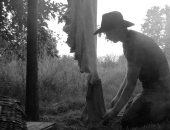




 I think I need to do steps 1, 2 and 3 while the hide is still fresh. I think steps 6 through 9 will be hard to do if it's freezing and cloudy.
I think I need to do steps 1, 2 and 3 while the hide is still fresh. I think steps 6 through 9 will be hard to do if it's freezing and cloudy.
I make a Maple Syrup instructional movie! Check it out HERE
SKIP books, get 'em while they're hot!!! Skills to Inherit Property
See me in a movie building a massive wood staircase:Low Tech Lab Movie











 1
1





I make a Maple Syrup instructional movie! Check it out HERE
SKIP books, get 'em while they're hot!!! Skills to Inherit Property
See me in a movie building a massive wood staircase:Low Tech Lab Movie





List of Bryant RedHawk's Epic Soil Series Threads We love visitors, that's why we live in a secluded cabin deep in the woods. "Buzzard's Roost (Asnikiye Heca) Farm." Promoting permaculture to save our planet.




I make a Maple Syrup instructional movie! Check it out HERE
SKIP books, get 'em while they're hot!!! Skills to Inherit Property
See me in a movie building a massive wood staircase:Low Tech Lab Movie
















List of Bryant RedHawk's Epic Soil Series Threads We love visitors, that's why we live in a secluded cabin deep in the woods. "Buzzard's Roost (Asnikiye Heca) Farm." Promoting permaculture to save our planet.
 1
1




Standing on the shoulders of giants. Giants with dirt under their nails

|
Self destruct mode activated. Instructions for deactivation encoded in this tiny ad.
Homestead Pigs Course
https://permies.com/wiki/365748/Homestead-Pigs
|



